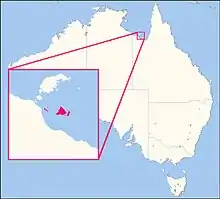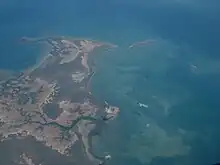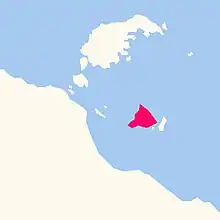| South Wellesley Islands Queensland | |
|---|---|
 South Wellesley Islands | |
| Coordinates | 17°00′13″S 139°21′48″E / 17.0037°S 139.3634°E |
| Population | 0 (2016 census)[1] |
| • Density | 0.000/km2 (0.000/sq mi) |
| Postcode(s) | 4871 |
| Area | 144.2 km2 (55.7 sq mi) |
| Time zone | AEST (UTC+10:00) |
| LGA(s) | Shire of Mornington |
| State electorate(s) | Traeger |
| Federal division(s) | Kennedy |

The South Wellesley Islands is an island group and locality in the Gulf of Carpentaria within the Shire of Mornington, Queensland, Australia. The group is separate from the Wellesley Islands.
Bentinck Island is the only one known to have been inhabited in the past; in the 2016 census, the South Wellesley Islands were uninhabited
Geography
The islands, which lie in the Shire of Mornington, are (west to east):[2]
- Allen Island
- Horseshoe Island
- Albinia Island
- Bentinck Island
- Fowler Island
- Sweers Island
In the 2016 census, the South Wellesley Islands had a population of 0 people.[1]
History
Kayardild language (also known as Kaiadilt, the name of the people of Bentinck Island, also spelt Gayadilta) is a language of the Gulf of Carpentaria. The Kayardild language region includes the landscape within the local government boundaries of the Mornington Shire Council.[3]
Explorer Matthew Flinders charted the islands in 1802 and assigned European names to Bentinck Island,[4] the island group (Wellesley) and the largest island (Mornington Island) in honour of Lord William Bentinck, who was then Governor of Madras, India,[5][6] and Richard Wellesley, 2nd Earl of Mornington and Governor-General of Bengal. In 1803, the two men had acted as interceded on Flinders' behalf to persuade the French to release Flinders after he had been imprisoned by them on Mauritius.[7]
Sometime around 1916, a man remembered only as McKenzie came to Bentinck Island and set up a sheep run, basing himself on a site at the mouth of the Kurumnbali estuary. He would ride over the island, accompanied by a pack of dogs, and shoot any Kaiadilt man who came within sight; in local memory, he murdered at least 11 people. He also kidnapped and raped native girls. He then moved to Sweers Island, and set up a lime kiln there. The Kaiadilt managed to return to Sweers only on McKenzie's departure. The massacre was only recorded by researchers in the 1980s.[8]
Sweers Island was declared an Aboriginal reserve in 1934. After a cyclonic tidal surge swept the area in 1948, which followed fast on the severe drought that struck in 1946, the Kaiadilt were transferred by missionaries and the Queensland Government to Mornington Island, the largest island in the group. The uprooting effectively set in place the process of the destruction of both Kaiadilt culture and language since all children were restricted to dormitories, away from their parents and kin, and the transmission of the language and lore was lost. On Mornington Island they lived in a separate zone, in beach humpies facing Bentinck Island. They were looked down on by the Indigenous Lardil people of Mornington Island, who denied them access to the fishing grounds. Conditions were so severe that for several years all children were stillborn, creating a gap in the generations.
 Southern part of Bentinck Island and Albinia Island
Southern part of Bentinck Island and Albinia Island Bentinck Island with the Australian continent in the background
Bentinck Island with the Australian continent in the background the small Fowler Island is located between Seers Island and Bentinck Island
the small Fowler Island is located between Seers Island and Bentinck Island Location of Bentinck Island
Location of Bentinck Island Southern part of Sweers Island
Southern part of Sweers Island
References
- 1 2 Australian Bureau of Statistics (27 June 2017). "South Wellesley Islands (SSC)". 2016 Census QuickStats. Retrieved 20 October 2018.
- ↑ "South Wellesley Islands – locality in Shire of Mornington (entry 42537)". Queensland Place Names. Queensland Government. Retrieved 13 November 2019.
- ↑
 This Wikipedia article incorporates CC-BY-4.0 licensed text from: "Indigenous languages map of Queensland". State Library of Queensland. State Library of Queensland. Retrieved 5 February 2020.
This Wikipedia article incorporates CC-BY-4.0 licensed text from: "Indigenous languages map of Queensland". State Library of Queensland. State Library of Queensland. Retrieved 5 February 2020.
- ↑ Milton, Vanessa (19 February 2022). "Bentinck Island's 'last people' fight for their homeland after a lifetime of dispossession". ABC News (Australian Broadcasting Corporation). Archived from the original on 24 February 2022. Retrieved 24 February 2022.
- ↑ "Sweers Island". State Library Of Queensland. 29 September 2014. Archived from the original on 26 February 2022. Retrieved 26 February 2022.
- ↑ Cox, J. (2022). Dillon: The drove to Port Darwin: Northern Territory Australia 1872. BookPOD. p. 266. ISBN 978-1-922270-74-0. Archived from the original on 15 July 2022. Retrieved 26 February 2022.
- ↑ "Mornington Shire". Queensland Places. Centre for the Government of Queensland, University of Queensland. Archived from the original on 26 February 2022. Retrieved 26 February 2022.
- ↑ Kelly, Roma; Evans, Nicholas (1985). "The McKenzie massacre on Bentinck Island" (PDF). Aboriginal History. 9 (1). Archived (PDF) from the original on 11 February 2020. Retrieved 13 April 2020.